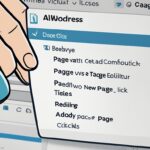Table of Contents
Are you looking to enhance your website’s content and make it more visually appealing? Look no further than WordPress, the leading content management system used by millions of website owners worldwide. In this WordPress page editing guide, we will provide you with quick tips on how to edit pages in WordPress effectively.
Editing pages in WordPress is a breeze thanks to its user-friendly editor, which offers an array of customization options. From adding engaging media to modifying the page layout, WordPress has everything you need to create stunning webpages. Whether you’re a beginner or an experienced user, these quick tips will help you make the most out of your WordPress editing experience.
Let’s dive in and explore the essential techniques to edit your WordPress pages like a pro. Whether you’re a business owner, blogger, or freelancer, these tips will equip you with the knowledge to elevate your website’s content.
Getting Familiar with the WordPress Editor
The WordPress editor is a block-based editor designed to simplify the process of creating and customizing content on your website. With its intuitive interface and versatile features, the WordPress editor offers a seamless editing experience for users of all skill levels.
One of the key features of the WordPress editor is its use of content blocks. Each block represents a different element of your content, such as paragraphs, images, lists, and more. These blocks can be easily added, rearranged, and customized to suit your specific needs.
By exploring the different blocks and their customization options, you can create beautiful and engaging page layouts. Whether you’re looking to add multimedia elements, adjust formatting, or enhance the functionality of your content, the WordPress editor provides ample flexibility and control.
As shown in the image above, the WordPress editor allows you to effortlessly manipulate content blocks, ensuring a seamless editing experience. With just a few clicks, you can add and arrange blocks to create dynamic and visually appealing pages.
Exploring Content Blocks
Let’s take a closer look at some of the most commonly used content blocks in the WordPress editor:
| Block | Description |
|---|---|
| Paragraph | A basic block for adding and formatting text. |
| Image | Allows you to insert and customize images within your content. |
| List | Enables you to create both bulleted and numbered lists. |
| Quote | Highlights important text or quotes within your content. |
| Heading | Defines different sections and hierarchy within your content. |
| Table | Creates structured data tables to present information. |
These are just a few examples of the extensive range of content blocks available in the WordPress editor. By familiarizing yourself with these blocks and their capabilities, you can unlock the full potential of your website’s content.
Essential Tips for Efficient Editing
To enhance your editing experience in WordPress, there are several tips and tricks you can utilize. First, you can save time by using keyboard shortcuts to perform common formatting tasks. These shortcuts allow you to quickly apply bold, italics, or underline to selected text, without the need to navigate through the editor’s toolbar. By familiarizing yourself with these shortcuts, you can streamline your editing process and work more efficiently.
Additionally, you can adjust the line spacing in WordPress to create clear paragraphs and line breaks. This helps improve readability and makes your content visually appealing. To modify the line spacing, simply select the desired text and use the line spacing options provided in the editor. Experiment with different spacing to find the ideal balance for your page layout.
Furthermore, you can rearrange the edit screen to customize your workspace and focus on specific blocks. The WordPress editor allows you to drag and drop blocks, making it easy to rearrange them according to your preference. This feature enables you to have a more organized and efficient editing process, as you can prioritize important content and easily navigate between different sections of your page.
Keyboard Shortcuts in WordPress
| Shortcut | Functionality |
|---|---|
| Ctrl + B | Bold |
| Ctrl + I | Italic |
| Ctrl + U | Underline |
Line Spacing in WordPress
Line spacing is an important aspect of formatting your content. By adjusting the line spacing, you can make your text more legible and visually pleasing. In the WordPress editor, you have the flexibility to customize the line spacing according to your preferences. Experiment with different line spacing options to find the optimal setting for your page.
Rearranging the Edit Screen in WordPress
The ability to rearrange the edit screen in WordPress allows you to create a personalized editing experience. By dragging and dropping blocks, you can rearrange their order and prioritize important content. This feature helps you stay focused on specific blocks and improves your overall editing workflow.
Advanced Editing Techniques
Now that you’ve familiarized yourself with the basics of the WordPress editor, it’s time to unlock the full potential of your editing skills. By exploring advanced techniques, you can elevate the structure and appearance of your pages to create compelling content. Let’s dive into three key techniques:
Changing Font Size in WordPress
One way to make your content stand out is by adjusting the font size of specific blocks. By emphasizing important text, you can capture your readers’ attention and guide them through your page. To change the font size:
- Select the block you want to modify.
- In the toolbar, locate the Font Size option.
- Choose the desired size from the available options.
Experiment with different font sizes to find the perfect balance between readability and visual impact.
Adding Headings in WordPress
Headings not only enhance the structure and organization of your articles but also play a crucial role in improving SEO. Search engines use headings to understand the hierarchy of your content, making it easier for them to index and display your pages in relevant search results. To add headings:
Remember to use heading tags (H1-H6) in a hierarchical structure, starting with H1 as the main title and using lower-level headings for subheadings.
By incorporating descriptive and keyword-rich headings, you can optimize your pages for search engines while improving the readability and user experience.
Creating Tables in WordPress
Tables are excellent for organizing data in a clear and concise manner. Whether you’re presenting statistics, product features, or any other tabular information, WordPress allows you to easily create tables using the built-in table block. Here’s how:
- Click on the + icon to add a new block.
- Search for and select the Table block.
- Click inside the table to add rows and columns.
- Customize the table’s appearance and style using the block settings.
Tables provide a visually appealing way to present complex information, allowing your readers to digest the content quickly and efficiently.
By mastering these advanced techniques – changing font size, adding headings, and creating tables – you can elevate your editing skills in WordPress and create visually appealing and engaging pages.

Conclusion
In conclusion, mastering the art of editing pages in WordPress is essential for creating compelling and well-structured content. With the WordPress editor’s intuitive interface and a range of customization options, you have the power to create professional-looking pages.
By following the tips and techniques outlined in this guide, you’ll be able to navigate the editor with ease and make effective changes to your WordPress pages.
Whether you’re a beginner or an experienced WordPress user, these quick tips and advanced editing techniques will elevate your editing abilities and help you create a visually appealing website.
So, make the most of the WordPress editor’s capabilities, experiment with different layouts and formatting options, and unleash your creativity to build stunning web pages. Happy editing!
FAQ
Where can I access the WordPress editor?
The WordPress editor can be accessed by logging into your WordPress dashboard and selecting the page or post you want to edit. From there, click on the “Edit” button to open the editor.
What are content blocks in the WordPress editor?
Content blocks in the WordPress editor represent different elements of your content, such as paragraphs, images, lists, and more. You can add, customize, and rearrange these blocks to create engaging page layouts.
Are there any shortcuts I can use to speed up my editing process?
Yes, you can use keyboard shortcuts in WordPress to perform common formatting tasks quickly. For example, you can use **Ctrl+B** to make text bold and **Shift+Enter** to insert a line break.
How can I adjust the line spacing in my paragraphs?
To adjust the line spacing in your paragraphs, select the paragraph block and navigate to the block settings panel on the right side of the editor. There, you can find options to increase or decrease the line height.
Can I customize the workspace in the WordPress editor?
Yes, you can rearrange the edit screen in the WordPress editor to suit your preferences. By clicking on the three-dot menu in the top-right corner of the editor, you can hide or display different elements and focus on specific blocks.
How can I change the font size of specific blocks?
To change the font size of specific blocks, select the block you want to modify and navigate to the block settings panel. There, you can find options to adjust the font size, align text, and apply other formatting changes.
Why should I add headings to my articles?
Adding headings to your articles improves both readability for your readers and search engine optimization (SEO). Headings provide structure to your content, making it easier to scan and understand. Search engines also use headings to determine the relevance and hierarchy of your content.
Can I create tables within my WordPress posts?
Yes, you can use the built-in table block in the WordPress editor to create tables within your posts. Simply select the table block and customize it by adding or removing rows and columns, adjusting cell sizes, and styling the table as needed.












